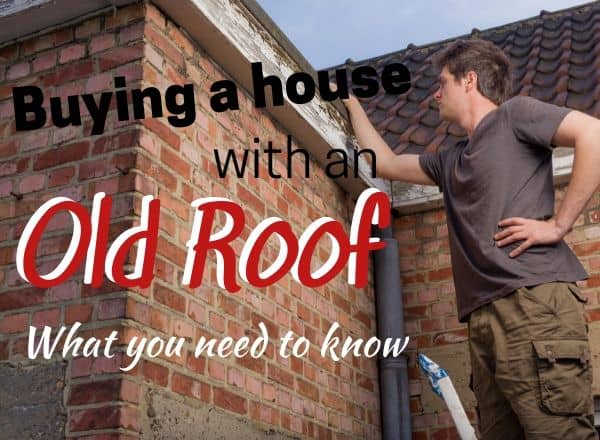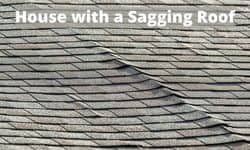Buying a House With an Old or Sagging Roof

Whether you are buying an old house as a primary residence or as an investment property, it’s important to ensure that you are aware of all possible issues old houses may have.
One of the most common issues associated with a house that is not brand new is it may have an old roof. If you ignore the roof’s condition and do not take this into account during or immediately after the purchase, it may lead to serious and costly problems later on.
Should I Buy a House with an Old Roof?
It is okay to buy a house with an old or sagging roof but a full inspection is recommended in addition to having a plan to repair or replace it in the near future.
Here are the things you should do before buying a house with an old roof:
1.Know the Roof’s Real Condition 
When you buy a house, understand that the roof may not be brand new, unless you are buying a house that has just been built. You need to find out how old the roof is, its real condition, and the degree of its wear and tear.
The older the roof, the more you may need to invest in having it repaired. You should inspect the roof and the attic space (if there is one) to see its physical condition. In many instances, you will learn more about the roof from its underside inside of the attic than you will from looking at it outside.
Another good idea is to ask the homeowner for documentation on the last time the roof was repaired.
2.Hire a Roof Inspector
It’s best to hire a professional roof inspector, not just a home inspector, to investigate the roof’s actual condition. The inspector will look for deteriorated shingles (or other roof coverings), or moist or rotted elements beneath the shingles, that may need immediate repair.
The roof inspector will thoroughly check if there are missing or loose roofing materials, and issue reports on the condition of ridges, caps, drip edges, drains, downspouts, and gutters.
The roof inspector can also give you an idea on how much a repair or replacement will cost and could also recommend a reputable company to do the work.
Getting a roof certificate is recommended especially if you are buying a very old house. A regular home inspection may not thoroughly inspect the full condition of the roof. Home inspectors could miss certain red-flags that could cost you a lot of money in the future.
With a roof inspection, you will understand how much additional investment you will need for the roof repairs so you can either negotiate the asking price with the seller or decide to find another house to buy.
3.Know the Cost of Roof Repairs
After you check the roof’s actual condition, you should get an estimate on the cost of repairs that you will need. It’s important to know how much you need to invest in repairs on top of the house’s selling price to help you make the right decision. It’s also essential to find out how long it will take to complete the repairs as this will affect your plans for moving in or having the house rented.
The cost of repairs will depend on the gravity of the roof’s condition. Most homeowners spend an average between $300 and $1,100 to repair a roof. Typically, minor repairs will cost around $150 to $400, moderate repairs will cost between $400 and $1000, while major repairs range from $1,000 to $3,000 or beyond. If the cost of repair is over $3,000, it may be best to replace the roof instead of having it repaired.
The cost to completely replace the roof will vary depending upon whether you live in a high cost area, the type of roof you have, and the materials you would like to use.
The cost to replace a roof can be anywhere from $4-$8 per square foot and would include the following:
- Removal of the old roof
- Cost of new materials
- Installation of new roof
- Adding a ridge vent
- Replacing chimney flashing
- Ice barrier cost and installation
- Cleanup and disposal of any debris
The roofing materials will play a major role in determining the true cost of the repair or replacement. You can also expect additional charges if any sheathing needs to be replaced or of there is any other structural damage to deal with.
Complexity of the roof installation may also add more costs. For example, if the roof has a very steep pitch and if there are many valleys and intricate details like you may find in an older home.
4.Weigh Your Options
When you have all the information that you need, it’s time to weigh your options. Consider the overall condition of the roof, the cost of repairs, the time needed to repair it, and the house’s selling price. You can negotiate the price with the seller or ask the seller to do the necessary repairs before you move in.
In a sellers’ market, however, the sellers may not be as open to certain negotiations. When this happens, take into consideration the actual cost of buying the house, including the cost of repairs, your budget, and how soon you want to move in. If you think the house’s cost and condition don’t align with your personal goals, perhaps it’s best to consider looking for another house instead.
The most important decision is whether to have the seller make the repairs or whether you would like a reduction in the cost of the home and then you manage the repairs yourself.
Pros and Cons of Buying a House With an Old Roof
While an old roof may have undergone a certain degree of wear and tear, it doesn’t necessarily mean that the roof is failing. Sometimes, regular preventive maintenance is the best way to extend the life of the roof.
Aside from the roof’s age, it’s also important to know how often it was maintained. Older roofs that are well-maintained are functionally better than a newer roof that is poorly maintained.
Here are the pros and cons of buying a house with an old roof:
Pros
-
- It gives you a reason to negotiate the selling price.
- It’s a good opportunity for an upgrade and you can use the materials that you want.
- If the roof is properly maintained even if it’s old, you might as well be getting a bargain.
Cons
-
- The necessary repairs may be too costly.
- You need to set aside time to complete the needed repairs before you can move in.
- Depending on the extent of the damage, the process and cost of repairing and maintaining an old roof can cause you stress and headaches in the long run.
Buying a House with a Sagging Roof
It is okay to buy a house with a sagging roof if you have it inspected and have any structural issues remedied before or immediately after purchasing the home.
Many older homes have what appears to be a sagging roof and you can often see it with the naked eye from ground level. There will be a few reasons why your home may have a sagging roof.
Too Much Load On the Roof – The load that your roof can handle will be based upon the span of your rafters from the peak of the roof down to the exterior wall. The longer the span, the more difficult it will be to support the load. The other factor is the roof pitch. The steeper the roof the more load it can hold. When roofs get older, many homeowners just install a second roof over the top of the original roof. Although this is a less expensive way to put a new roof on your home, you will have double the weight which can cause your roof to sag.
Poor Architectural Design – Building standards change over time and what was allowed decades ago (ie aluminum wiring) may no longer be acceptable. It is possible that the home was improperly designed and that supports may be needed beneath the rafters to deal with the load and sag in the roof. This is something that a roofing expert and even a building engineer should be able to help with.
Water Damage – If the roof shingles were compromised and the sheathing below was able to get wet, then it can result in a sagging roof. The only way to remedy this is to remove the old roof and replace all of the damaged sheathing. Then, install a new roof.
Incorrect Rafter Materials – It is unfortunate, but many years ago builders would take short cuts to save on building materials. A possible reason for the sagging roof but not likely is the use of incorrectly sized rafter materials. For example, the builder could have used 2×8 boards when the plans called for 2×10 material. Doing this would compromise the ability for the roof to perform under load.
Improper Rafter or Truss Installation – The lumber used for roof rafters often have a natural crown to them. They should be installed with the crown (or hump) facing upwards. If the framer is not paying attention or is inexperienced, the rafter could be installed upside down. This would result in a visual sagging of the roof. If the board has a severe crown, then it is something you would be able to see immediately after construction. One way to deal with this issue would be to install a new rafter right up against the old one while lifting the roof up to remove the sag.
Foundation or Floor Problems – Another potential reason for a sagging roof is there could be a structural problem below the attic. It could be that one of the floors below or even the foundation has dropped. This could result in the entire house sagging all the way up to the roof. If this happens, you would likely also see cracking of the walls in the rooms directly below the sagging roof. This would be a more complicated and expensive repair.
Most of these issues can be corrected to either prevent the roof from continuing to sag or to even raise the area that has been sagging. If the sagging roof has been inspected and there are no structural issues, it still may be okay to purchase the home but you will have to deal with the visual eye sore.
How Much Sagging Roof is Acceptable
Any amount of sag in a roof is a concern and should be investigated by a professional but a slight sag can be okay if there are no structural issues. However, anything more than a slight sag should be remedied immediately if you already own the home, or soon after making the purchase if this is a home that you are looking to buy.
If you have a slight sag and an inspector or architect says there are no structural issues and the sheathing is not wet, then you may just have to get used to the idea that your roof looks like it is sagging a bit.
How to Negotiate a New Roof when Buying a Home
If you are purchasing a home with an old or sagging roof, you may be able to negotiate a new roof prior to making the purchase. There are multiple ways this can happen:
Seller Replaces the Roof – In a buyer’s market, you may be able to get the seller to replace the roof before the closing date. This would be optimal because it is the seller’s responsibility to make sure the job is done correctly. We recommend paying for a follow up inspection of the roof before closing on the home.
Seller Provides a Credit at Closing – In many instances especially when there is little time to replace the roof before closing, the seller can provide a credit at closing to have the roof replaced. The best way to deal with this is to get multiple estimates from roofing companies to use during your negotiation with the seller. One benefit of doing it this way is that you now control the quality of the roof repair.
FHA 203k Rehab Loan For Roof Replacement
If you are going to purchase a home that needs a new roof, you should consider the FHA 203k rehab loan. With this mortgage program, you can include the rehab funds needed to replace the roof into your mortgage when you purchase the home.
You will need an estimate for the roof before you close on the home. Suggest using the highest roofing estimate but then go with the company that you feel most comfortable with to actually do the work. The lender will disburse the funds to pay for the roof after the work is completed and inspected by an FHA 203k consultant.
Read more about FHA 203k Rehab Loans.
Know When to Walk Away from a Home with an Old or Sagging Roof
Buying a house with an old roof may not be the best option for you. If the cost of roof repairs will put a significant strain on your budget, it’s best to look for other options and find a different house instead. Keep an eye out for red flags that may indicate the house is not worth your time and money.
Here are three things you should watch out for:
- Structural Damage. If the roof is sagging due to structural damage, it’s a clear indication that the house is not worth investing in. Structural damage may not only affect the roof — you may need to do more repairs on other areas of the house too. Buying a house with structural damage will cost you more money and stress.
- Algae overgrowth. If the roof inspector finds moss and algae growth on the exterior shingles, it’s another red flag that the roof may be too expensive to fix. Moisture in the attic space is often caused by poor ventilation and this requires more work that could be very costly.
- Excessive water damage. Leaks that are not fixed immediately could damage the ceiling and the house’s interior walls. If you notice water stains, feel the affected area to check for signs of mold and mildew.
While buying a house with an old roof is possible, it’s important to know what you are dealing with. Be ready to invest time in negotiating with the seller, or prepare yourself with the possible cost of repairs or replacement.
When making a decision, it’s best to consider the property as a whole rather than focus on a single feature like the roof. A roof can be repaired or replaced easily but it is much harder to change the layout of the home and impossible to change its location.
In the end, buying a home with an old roof is fine provided you got it inspected, factored in the cost to repair or replace, and received compensation from the seller.
Related Articles
Buying a Home with an Old Septic System – Septic systems can be very expensive to repair or replace. Make sure you know what to look for before purchasing the home.
Buying a home with Aluminum Wiring – Homes built in the late 60’s and early 70’s may have aluminum wiring. There are a few things you need to know before purchasing a home with aluminum wiring.
FHA 203k Rehab Loan – If you are buying a home that needs repairs such as a new roof, you may be able to purchase the home and also include the cost of all repairs with an FHA 203k rehab loan.

